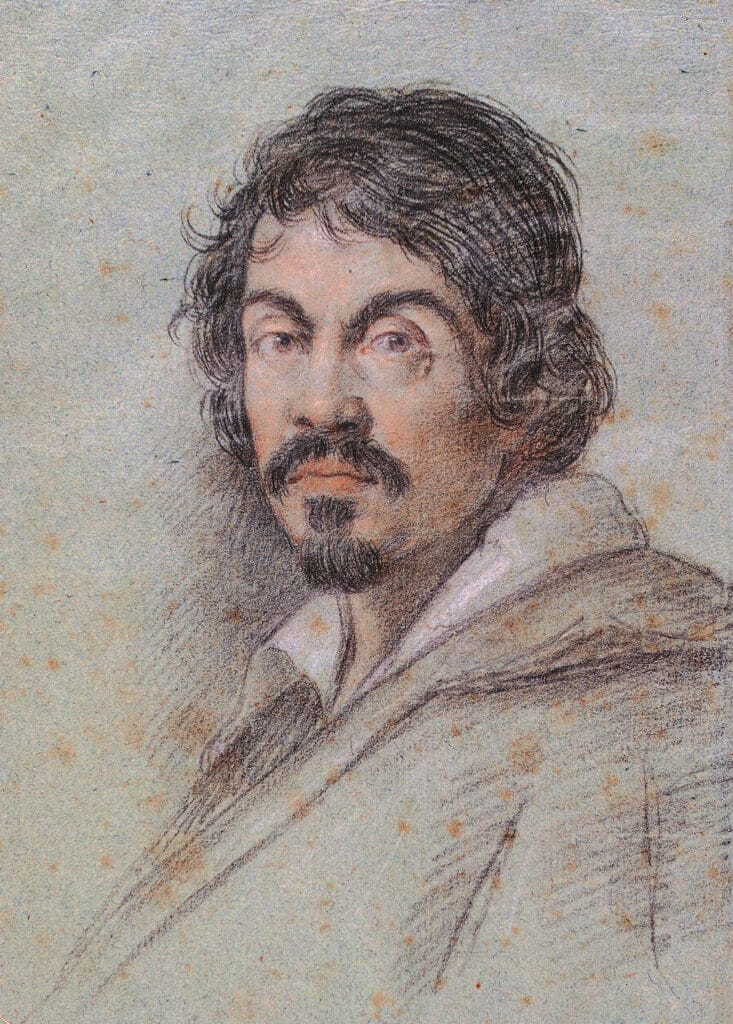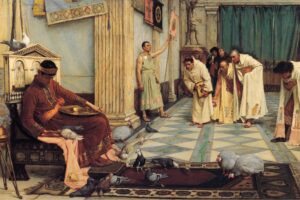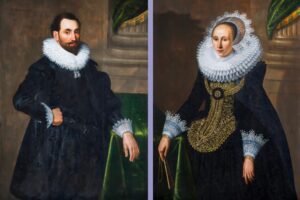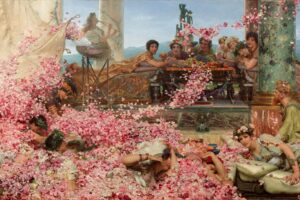Supper at Emmaus – Caravaggio, 1601
In a quiet inn in the town of Emmaus, a meal becomes a miracle. Caravaggio, master of dramatic realism and sacred intimacy, captures not just a biblical story, but the moment when the ordinary cracks open to reveal the divine. In Supper at Emmaus, painted in 1601, light pours into darkness and faith returns with a gasp.
The Scene Before Us
The painting shows four figures around a modest table: bread, wine, roasted chicken, fruit. A man in red — gentle, composed — blesses the food. The other three react not with reverence, but with shock. One leaps from his chair, arms flung wide. Another leans forward, eyes alight with realization. The innkeeper, still unaware, stands behind them, serene and unmoved.
That man in red is Christ — risen, yet unrecognized until this moment. The two disciples, who had walked beside him all day without knowing, suddenly see. It is the breaking of bread that breaks the illusion.
Caravaggio uses light like a revelation. The fruits shine with polish, the white tablecloth glows, shadows fall in sharp edges. The moment is not soft — it is electric.
The Deeper Meaning
Caravaggio takes a holy event and makes it earthly. These are not idealized saints — they are men with wrinkled sleeves, dusty shoes, stunned expressions. The miracle happens not in a temple, but at a tavern table.
And that is the genius of the painting: the sacred lives among the common. God breaks bread in ordinary homes. The divine knocks quietly, and we may not recognize Him until He is gone.
The figures’ surprise is ours. We, too, miss the miracle. We walk beside grace unaware. We sit at our tables thinking only of hunger — until the moment something shifts, and we realize we have been in the presence of something greater all along.
A Moment Caught in Time
This is not the resurrection itself — it is the recognition of it. That subtle shift from blindness to knowing. And it is frozen here forever in oil and canvas: the lifted hands, the startled eyes, the silence before speech.
Caravaggio does not tell us what happens next. He only shows us this: the moment belief returns, not through thunder or angels, but through the simple gesture of blessing a meal.
It is a scene of divine surprise. And perhaps that is why it remains so powerful — because it reminds us that wonder is not gone. It may be sitting right across the table.
About Artist

Michelangelo Merisi da Caravaggio (1571–1610) was an Italian painter who single-handedly revolutionized painting and became a pivotal figure of the Baroque art movement. Living a tumultuous and often violent life, he created a body of work that was both intensely realistic and profoundly dramatic. His radical approach broke away from the idealized forms of the Renaissance and Mannerism, influencing a generation of artists known as the Caravaggisti.
Artistic Innovations
Caravaggio’s genius lies in his revolutionary use of a technique now known as tenebrism. This is an extreme form of chiaroscuro that uses a dramatic, single light source to create stark contrasts between light and dark, plunging the background into deep shadow while illuminating the figures in a theatrical spotlight. This technique heightens the emotional intensity of his scenes.
He also shocked his contemporaries with his radical naturalism. Unlike artists who used idealized models, Caravaggio often painted directly from life, using real people—including beggars, laborers, and prostitutes—as models for his saints and biblical figures. This brought a new, raw, and often shocking level of humanity to religious subjects. His paintings feel immediate and tangible, as if the sacred events are unfolding in a contemporary, ordinary setting.
Notable Works
- “The Calling of Saint Matthew” (1599–1600): This masterpiece, housed in the Contarelli Chapel in Rome, is a perfect example of his style. A single ray of light from an unseen source illuminates the tax collectors in a dark room as Christ, on the right, calls Matthew to follow him. The scene feels less like a historical event and more like a pivotal, everyday moment.
- “Basket of Fruit” (c. 1599): A truly groundbreaking painting, this is one of the earliest examples of a stand-alone still life in Italian art. Rather than depicting perfect, idealized fruit, Caravaggio rendered the basket’s contents with unflinching realism, including wormholes in an apple and a shriveled leaf. This work is often interpreted as a “memento mori,” a reminder of the transience of life and the inevitability of decay.
- “Judith Beheading Holofernes” (c. 1599): This intensely violent and psychological painting depicts the biblical heroine Judith in the act of beheading the Assyrian general. The scene is full of drama and emotion, with Judith’s face conveying a mixture of determination and revulsion.
- “The Supper at Emmaus” (1601): This work captures the moment the disciples recognize the resurrected Christ. The gestures are explosive, with one disciple’s arms outstretched in shock. The illusion of a meal on the table, with a basket of fruit seemingly about to topple off, brings the divine event into the viewer’s immediate space.
- “The Entombment of Christ” (1602–1603): Considered one of his greatest masterpieces, this painting focuses on the raw grief of those lowering Christ’s body into the tomb. The light, the weight of the bodies, and the powerful expressions of sorrow create a moving and unforgettable devotional image.



